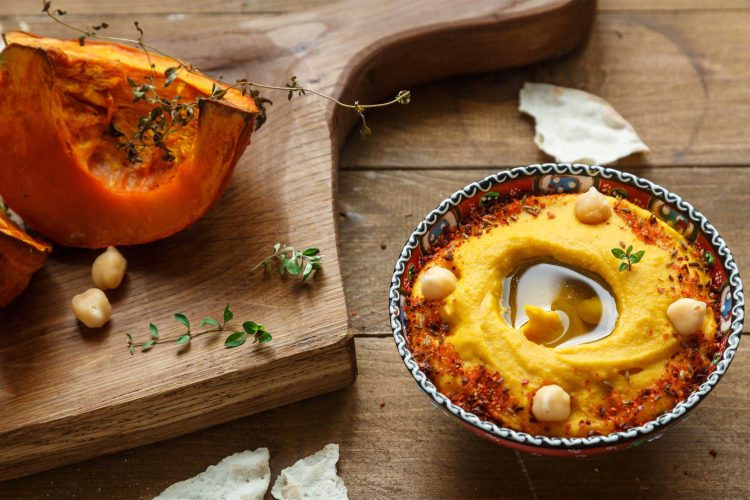Saviez-vous que nous publions une recette pratiquement tous les mois ? C’est maintenant plus de 25 recettes que vous retrouvez sur le blogue de Vitoli dans le sujet « Recettes ». Ce mois-ci nous avons retenu une demande spéciale antérieure : une recette d’houmous.
Pour d’innombrables raisons de santé, dont le vieillissement cellulaire, consommer plus de protéines végétales serait une clé vers la longévité. Le remplacement des protéines animales pour des protéines végétales, en tout ou en partie, serait corrélé avec la longévité et la réduction des risques de maladies cardiovasculaires. Pour ce faire, il vous faut quelque chose de notamment savoureux qui vous donnera envie d’en manger encore et encore!
À cet effet, le houmous est parfait pour vous; il contient des pois chiches, qui comme toute légumineuse, est hautement protéiné. Le « Tahini » ou encore la pâte de sésame fournit un apport considérable en méthionine; un des huit acides aminés essentiels. Le sésame est aussi un aliment riche en fibres, et sa matière grasse est principalement monoinsaturée.
Nous avons décidé d’ajouter une riche dose de bêta-carotène et de zéaxanthine avec la courge. Il vous suffira d’avoir, sous la main, une variété de légumes pour faire trempette, des craquelins ou des morceaux de pain à grain entier. Avant de vous offrir notre petit bijou doré, nous aimerions vous partager un peu son histoire.
La culture du pois chiche commença il y a 9 900 ans. Les premières mentions du houmous datent du 8e siècle avant Jésus-Christ en Mésopotamie, maintenant nommée l’Irak, en majeure partie. La forme moderne de cette délicieuse purée serait apparue dans l’Empire ottoman durant le 15e siècle. Huit candidats se battent pour savoir son véritable pays d’origine. Parmi eux, le Liban, l’Israël et la Palestine sont les plus actifs à ce sujet; ils ont été suivis de près par la Grèce, la Turquie, la Jordanie, la Syrie et l’Égypte. On peut dire d’emblée que chacun de ces pays respectifs intègre les pois chiches, sous plusieurs formes, dans leur gastronomie.
Nous sommes convaincus que notre houmous à la courge rôtie sera au-delà d’une simple trempette à légumes; il sera également le meilleur condiment à intégrer à vos sandwiches. Bref, vous ne pourrez-vous empêcher de l’intégrer à vos habitudes alimentaires!
Houmous à la courge rôtie
Ingrédients
– 3 tasses de courge à chair orangée rôtie et refroidie
(Butternut (musquée), Buttercup (Kabocha) ou Hubbard)
*environ une courge moyenne
– 1 canne (environ 2 tasses) de pois chiches rincés et égouttés
-7-8 feuilles de sauge fraîche
(ou)
-1 à 2 branches de romarin coupées en deux
-6 gousses d’ail rôties
-1 cuillerée à thé de graines de cumin et coriandre
(Torréfiées à sec)
-Sel et poivre au goût
– 1 tasse de pâte de sésame (Tahini)
– ½ tasse d’huile d’olive
-1/2 tasses de jus de citron frais + eau au besoin
– Persil fraîchement ciselé au goût
*Robot culinaire
*Plaque de cuisson en acier inoxydable foncée
*Papier parchemin
Étapes
- Nous vous conseillons d’avoir de la purée de courge prête, bien refroidie. Sinon passez à la deuxième étape, dans laquelle je vous expliquerai comment procéder. Par la suite, on passera à la troisième étape pour la confection du houmous.
- Préchauffez votre four à 375 degrés Fahrenheit. Pendant ce temps, recouvrez votre plaque de cuisson d’un morceau d’un papier parchemin couvrant la surface. Coupez votre courge moyenne en deux à l’aide d’un gros couteau assez tranchant, car ce légume est assez ferme. Réservez six gousses d’ail, ainsi que vos herbes fraîches choisies, soit la sauge ou le romarin selon le choix que vous avez fait. Vous déposerez trois gousses d’ail et la moitié des herbes sur chacune de vos moitiés de courge. Prenez soin de percer, à l’aide d’une fourchette ou la pointe d’un couteau, la peau des courges, cela permettra d’aider à la cuisson. Enfournez maintenant ces beautés dorées pendant 30 à 45 minutes.
- Une fois, votre curcubitacé cuit, à l’aide d’une cuillère à soupe, vous raclerez la chair contre la pelure du légume. Dans un contenant de plastique, vous laisserez refroidir la chair et les gousses d’ail rôties. Dans un petit poêlon, faites torréfier les épices (cumin et coriandre) à feu moyen, jusqu’à ce que ces dernières embaument. Cette opération peut prendre 4-5 minutes tout au plus. Une fois grillées, transférez-les dans un petit plat de verre pour les tempérer rapidement. En principe, la chair de votre citrouille sera prête à l’usage, puis vous pourrez passer à la prochaine étape.
- Dans votre robot culinaire, mettez tous les ingrédients dans le récipient : la courge et ses aromates, les pois chiches, les épices, le tahini, l’huile d’olive, le jus de citron frais, sel et poivre au goût. Pulsez la préparation à basse vitesse, jusqu’à ce que le tout soit homogène. Si vous vous apercevez que la mixture est un peu trop épaisse, ajoutez de l’eau peu à peu en pulsant, de manière à avoir la consistance désirée. Transférez votre houmous, dans des plats de service à couvercle, avec lesquels vous pourrez les réfrigérer. Parsemez les plats de houmous avec du persil fraîchement ciselé si désiré. Vous êtes maintenant en mesure d’épater vos convives lors d’une fête, ou encore revamper votre sandwich préféré, même celui aux tomates! Passez un bel été et bon appétit à tous!
Références :
- Huang J, Liao LM, Weinstein SJ, Sinha R, Graubard BI, Albanes D. Association Between Plant and Animal Protein Intake and Overall and Cause-Specific Mortality. JAMA Intern Med. 2020 Sep 1;180(9):1173-1184.
- Song M, Fung TT, Hu FB, Willett WC, Longo VD, Chan AT, Giovannucci EL. Association of Animal and Plant Protein Intake With All-Cause and Cause-Specific Mortality. JAMA Intern Med. 2016 Oct 1;176(10):1453-1463.
- Naghshi S, Sadeghi O, Willett WC, Esmaillzadeh A. Dietary intake of total, animal, and plant proteins and risk of all cause, cardiovascular, and cancer mortality: systematic review and dose-response meta-analysis of prospective cohort studies. 2020 Jul 22;370:m2412.






